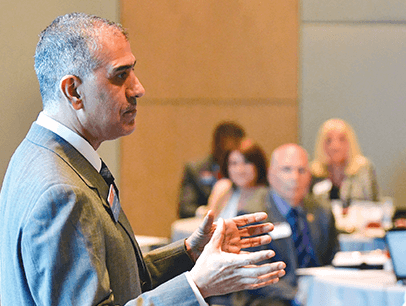Early in his career, a senior colleague told Allan Watkinson he was showing good leadership. At the time, he was a junior person in the organization and didn’t see himself as a leader.
Now Watkinson is a leadership, talent, and engagement expert and principal at Gallup, a global analytics and advising firm. He remembers that early leadership lesson clearly. “The senior colleague observed me being proactive around a purpose and a goal and getting things done in an environment where others weren’t getting things done,” he says.
That’s a key part of how Watkinson views leadership. At the core, he says it’s about moving people and projects toward a common goal and in a positive direction.
Too often people associate leadership with a title. However, you don’t need a title to be a leader. And not all people with titles are leaders. “People can be CEOs of a company, but they don’t have leadership skills,” says Juana Duque, senior client partner at Korn Ferry, a global organizational consulting firm. “Some CEOs have the worst leadership skills.”
For real leadership, it’s not the title that’s important. It’s what you do that matters.
Christina Tushman, senior director of learning design and leadership development at the Association of American Medical Colleges (AAMC), agrees. She describes leadership as something you do—a behavior you exhibit. “It’s not necessarily a position,” she says. “It can be, but you need to have the accompanying behavior.”
So, what happens when you’re asked to lead—or you’re assigned—a project at work but you don’t have official supervisory responsibility over any of the project’s team members? This scenario happens all the time. “You can demonstrate leadership in this moment,” says Watkinson. “You can start now.”

Key Leadership Behaviors
Watkinson suggests people who are leading a team without the title or supervisory responsibility focus on four actions:
1 Think.
Be future oriented and think strategically about the path you’ll take to accomplish the project. What are the parameters to navigate, such as budget and timeline? What does success look like? Be clear about the project goal and desired outcome.
It’s also essential you understand what’s expected of you and your team. Make sure all members of your team understand what’s expected of them too.
2 Build.
You need to build trust and engagement in your team. To do so, you must know yourself and your team.
Leaders invest time in knowing themselves. What drives you? What are your strengths? What are your weaknesses and how can you fill in those gaps? “It’s hard to lead people if you don’t know yourself well,” says Watkinson.
A common mistake is believing you have to do it on your own and have all the answers. AAMC’s Tushman emphasizes you’re not building the collective capacity of the organization if you try to do everything yourself.
For real leadership, it’s not the title that’s important. It’s what you do that matters.
You also risk alienating your team. It’s important to have a highly engaged team around you, so get to know each team member. What are their strengths and weaknesses? Organize your team around those strengths and leverage their power.
But don’t stop there. Understand what’s important to them, how they’re being measured in their role, and what they’re trying to achieve. “You have to care about the people you’re working with,” says Tushman. “You have to care about who they are and what’s going on in their world.”
Focus on building trust too. It’s important to follow through on what you say you’ll do and to keep confidences. If you lose your credibility, it’s hard to gain it back.
3 Influence.
There are many people you will need to influence to accomplish the job. Your team members are essential, but they are not the only ones. Who are your target audiences? Who are the recipients of what you’re delivering? Who are the people who can clear roadblocks for you? Map these out.
If you want to be seen as someone leading the way, you need to understand where to spend your time and how to most effectively communicate with your team and other audiences to activate them. Some people need logic, data, facts, and charts. Other people respond to inspiration, shared meaning and purpose, and common values. Others might be motivated by the way a person delivers a message, such as a confident and direct approach. “You can get a good project manager who’s focused on the transactional parts, but a leader will influence the right people,” says Watkinson.
4 Execute.
This is all about getting the job done. Focus on a plan with clear milestones. Monitor progress and the budget. Be aware of upcoming deadlines while keeping the overall goal in mind.
It’s also important to be a positive force and lead by example. “You have to have positive energy and the motivation for helping others through something—or for transforming something,” says Duque.
Don’t forget to share credit with your team members and others you work with. While you should share your own successes, it’s important to shine the spotlight on others even more. Also, look for ways to develop your team members so they have opportunities to grow.
It’s rare for someone to be strong in all four behaviors. Good leaders build a team around themselves to ensure the core capabilities are represented.

Structural and Cultural Influences
An organization’s structure, or culture, or the society in which it’s based can greatly affect how leadership is viewed and how you can get things done. “You have to read the room,” says Tushman. “You have to know the culture of your organization and how an organization rewards and recognizes leadership.”
Is your organization hierarchical? Is it collaborative? Is it more organic, with very few positional titles? The organizational structure can make a difference, as well as how the top leader decides to use power.
Watkinson sees more organizations moving to a matrix structure, where people have multiple bosses and can be torn about who to take guidance from. Leaders have less official authority and must be more influential, which often challenges people to lead in a different way.
In a flat organization—which is more project-based—someone may have a line manager, but the formal power of managers is gone. That opens the door for everyone to demonstrate leadership.
Younger workers want coaches rather than bosses. As a result, they respond better to influence than direction.
Duque has worked throughout Latin America and is currently based in Bogotá, Colombia. She describes the countries she works with as hierarchical societies, where titles are very important. People are used to a style of leadership where they’re told what to do, and they do it. “It’s been that way for a long time,” she says. “We are starting to change, but it’s slow.” Yet she’s seeing an evolution to more open and collaborative approaches.
Watkinson has lived around the world and is currently based in Sydney, New South Wales, Australia, working in the Asia-Pacific region. In Australia and New Zealand, he says the focus is mainly on leaders serving the needs of their people and managing outcomes rather than tasks. Whereas in Asia, a hierarchical environment is more common.
Both Duque and Watkinson see a difference in the younger generations across all cultures. Younger workers don’t want to be told what to do. Instead, they want to be empowered. “They just want to jump into things they can discuss and understand and do what they feel like they need to do,” says Duque. They want coaches rather than bosses. As a result, they respond better to influence than direction.
If you’re faced with leading a project team without formal authority—or even if you have the title—employ leadership behaviors, understand the culture you’re working in, and apply what you’re learning in Toastmasters to succeed at work.
“But don’t wait for the role,” says Watkinson. “Understand what leadership is and that you’re already a leader if you choose to be. Start today.”
Jennifer L Blanck, DTM has more than 25 years of career development and advising experience. She is a member of 5-Star Toastmasters Club in Arlington, Virginia, and AAMC Toastmasters in Washington, D.C., as well as a regular contributor to the Toastmaster magazine. Learn more at jenniferlblanck.com
Related Articles

Leadership
Leadership Is About Behavior, Not Titles

Leadership
Is Leadership for Me?

Club Experience



 Previous
Previous

 Use Toastmasters to Gain Leadership Skills
Use Toastmasters to Gain Leadership Skills
 Previous Article
Previous Article
